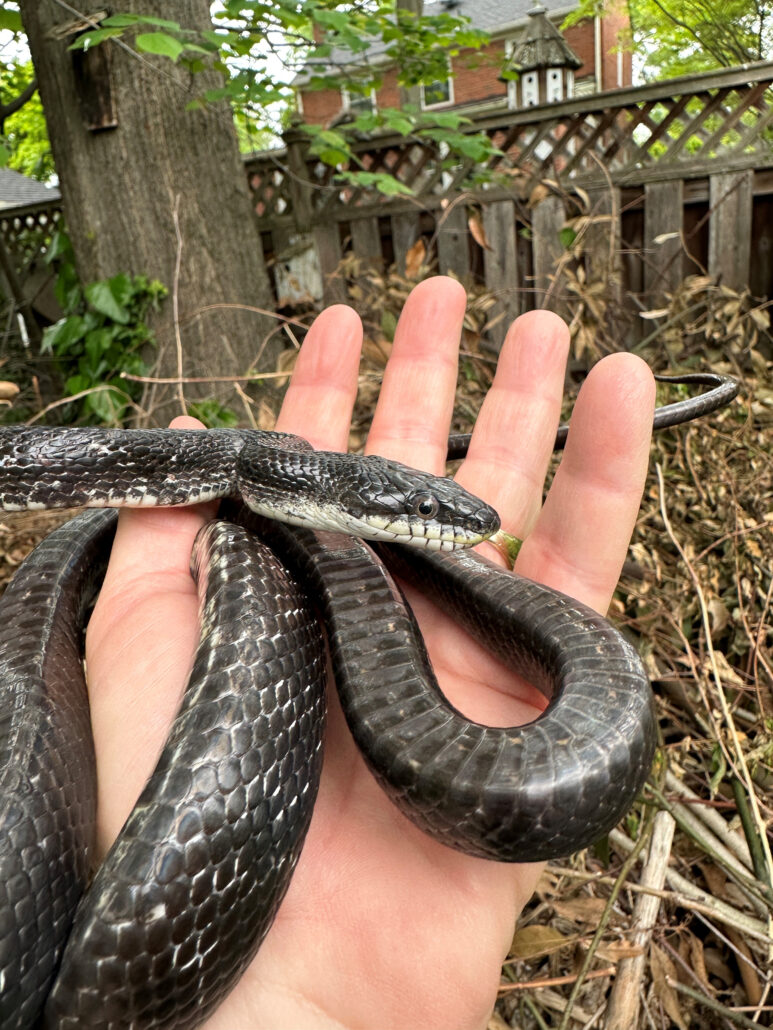By RICK BORCHELT

Photo Credit: Rick Borchelt
Spring is the time we’re most likely to see snakes in the D.C. suburbs; warmer temperatures lure them out of their winter shelter to bask in sunny spots, regulating their body temperature as they prepare to mate. Of the species we’re likely to see here, black snakes are the most commonly spotted.
But saying “black snake” is like saying “red bird”; that bird could be a cardinal, a house finch, a scarlet tanager — or any other bird with red in its plumage. Similarly, saying “black snake” could suggest either of two common, but very different, snakes that are, indeed, often black: the eastern rat snake and the eastern racer.
There’s a saying among herpetologists (people who study reptiles and amphibians) that if you see a snake in a very strange place, it’s probably a rat snake. Rat snakes are members of the genus Pantherophis, which includes about 10 North American species also commonly known as corn snakes and fox snakes. The species we’re likely to see here is the eastern rat snake (Pantherophis alleghaniensis).
A lot of folklore has grown up around eastern rat snakes, which can range in color from black to gray to yellow across their range east of the Appalachians. They’re known for raiding chicken coops, going after birds and eggs alike — earning them the name chicken snake. They’re also called pilot snakes in the belief that they lead other snakes (including venomous copperheads and rattlesnakes) to communal winter dens.
Black rat snakes are equally at home on the ground and in trees; rat snakes have scales that are keeled — each scale has a ridge — and the keeled scales can help the snake navigate and climb rough surfaces. But climbing is not without peril: More than a few black snakes have shimmied up a utility pole, clambered into an electrical transformer and shorted it out, with fatal consequences for the snake. They’re also adept at getting into attics and ceilings, and are a major predator of young squirrels and birds in their nests.
Eastern rat snakes are the longest of our snakes in the Mid-Atlantic, topping out at about seven feet. A snake that long is pretty old; they don’t even reach sexual maturity until they’re about four.
The other black snake we commonly see here in the spring is the eastern (or American) racer (Coluber constrictor). At first glance, racers might easily be mistaken for an eastern rat snake.
Side by side, though, physical differences between these two black snakes become more apparent. Where rat snakes have keeled scales, racers are very smooth, which helps them slip easily through brush and grass. Rat snakes usually look chunky, where racers are thin and streamlined. In cross section, rat snakes are sort of loaf-shaped, while racers are tubular. Racers end up a little shorter at maturity, around five feet long.
Most people see the biggest difference between these snakes in their faces, even at a distance. Eastern rat snakes have vertical black stripes across their lips, where the lips of racers are plain white.
Even though racers have constrictor as their species name, rat snakes tend to be the actual constrictors: They wrap their catch in muscular coils and suffocate it to death before swallowing it whole. In contrast, racers simply pin down and swallow their still-living meals. This means rat snakes can take larger prey than racers typically do. Neither species is venomous, and neither can chew its food, but both types of snake can unhinge their jaws to swallow seemingly impossibly large prey. But that’s where the behavioral similarities end.
Rat snakes are usually quite docile and can often be picked up and handled without getting agitated and biting you. Racers, on the other hand, are nervous snakes with a temper; they’ll strike repeatedly at you if they are cornered, and while they are not venomous, their bite can draw blood. Racers also vibrate the tips of their tails when alarmed, rendering a reasonable facsimile of a rattlesnake’s rattle when they’re vibrating in dry leaves or grass. (This unfortunate habit often gets them killed by uninformed people.) Racers also tend to move through their landscape with heads held high like a periscope for better vision.
Snakes in our area enter brumation during the winter, a deep torpor from which snakes can emerge any time the temperature is high enough for them to bask in the weak winter sunshine. Rat snakes in particular might choose your basement or attic for brumation, wrapping themselves around warm pipes or light bulbs or wedging into furnaces or water heaters. They’ll typically leave in the spring the same way they came in. Or a nervous neighbor calls me to move their scaly subletter along.
Have questions for Rick about the world of nature in and around the city, or suggestions for future columns? Drop him a note at rborchelt@gmail.com.







